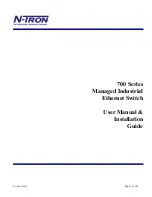
4-6
To do…
Use the command…
Remarks
Configure the
padding format for
Option 82
dhcp-snooping
information format
{
normal
|
verbose
[
node-identifier
{
mac
|
sysname
|
user-defined
node-identifier
} ] }
Optional
normal
by default.
Configure the code
type for the circuit ID
sub-option
dhcp-snooping
information circuit-id
format-type
{
ascii
|
hex
}
Optional
By default, the code type
depends on the padding
format of Option 82. Each
field has its own code
type.
This code type
configuration applies to
non-user-defined Option
82 only.
Configure
non-user-defined
Option 82
Configure the code
type for the remote
ID sub-option
dhcp-snooping
information remote-id
format-type
{
ascii
|
hex
}
Optional
hex
by default.
The code type
configuration applies to
non-user-defined Option
82 only.
Configure the
padding content for
the circuit ID
sub-option
dhcp-snooping
information
[
vlan vlan-id
]
circuit-id string circuit-id
Optional
By default, the padding
content depends on the
padding format of Option
82.
Configure
user-defined
Option 82
Configure the
padding content for
the remote ID
sub-option
dhcp-snooping
information
[
vlan vlan-id
]
remote-id string
{
remote-id
|
sysname
}
Optional
By default, the padding
content depends on the
padding format of Option
82.
z
You can enable DHCP snooping to support Option 82 on Layer 2 Ethernet interfaces only.
z
To support Option 82, it is required to perform related configuration on both the DHCP server and
the device enabled with DHCP snooping.
z
If the handling strategy of the DHCP-snooping-enabled device is configured as
replace
, you need
to configure a padding format for Option 82. If the handling strategy is
keep
or
drop
, you need not
configure any padding format.
z
If the Option 82 is padded with the device name (sysname) of a node, the device name must
contain no spaces. Otherwise, the DHCP-snooping-enabled device will drop the message.
















































